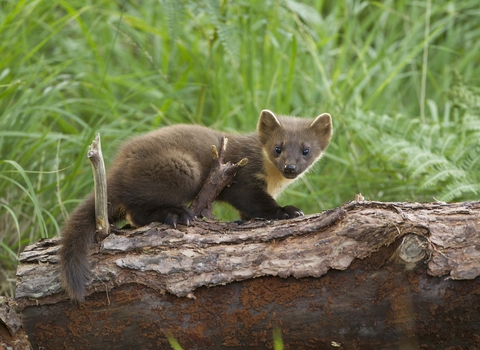
©Mark Hamblin/2020VISION
Pine marten
Scientific name
Martes martesWhen to see
January to DecemberSpecies information
About
An elusive mustelid, the pine marten is mostly found in the north of the UK, particularly Scotland. It prefers woodland habitats, climbing very well and living in tree holes, old squirrel dreys or even old bird nests. It feeds on small rodents, birds, eggs, insects and fruit, and can even be encouraged to visit birdtables laden with peanuts and raisins. During the summer mating season, they make shrill, cat-like calls. The following spring, the female will have a litter of between one to five kits, which are independent by autumn.How to identify
Mostly chestnut-brown in colour, the pine marten has a characteristic pale yellow 'bib' on its chin and throat. Each pine marten has a uniquely shaped bib, allowing individuals to be identified by the pattern. The pine marten also has a long, bushy tail.Distribution
Mainly found in Scotland, particularly in the Highlands, and Ireland. Populations in northern England and North Wales are fragmented and small. They have also been successfully reintroduced to the Forest of Dean.In our area
Gloucestershire Wildlife Trust, Forestry England, Forest Research and Vincent Wildlife Trust collaborated to successfully reintroduce pine martens to the Forest of Dean and lower Wye Valley, with the support of Forest Holidays and the Woodland Trust.
Between 2019 and 2021, following feasibility studies, 35 pine martens were successfully reintroduced into the Forest of Dean to bolster the expanding Welsh population and help establish a resilient pine marten population in the south-west of England. No further translocations will be undertaken in Gloucestershire and this recovering population will be monitored as it continues to expand and spread throughout the region. As of 2022, the population is thought to be just over 40 animals, with at least 4 litters of kits being born so far.
Did you know?
Bilberries, rowan berries and blackberries make up much of a pine marten's summer diet, often resulting in its 'scats' (droppings) turning blue or red in colour. Pine martens regularly leave their scats on forest trails or in prominent places like boulders to mark their territories. When they are fresh, scats may have a slimy appearance due to mucous binding them together. They may contain fur, feathers, bones or seeds.Watch
Pine marten © Russell Savory (https://vimeo.com/366515239/3b94160fd7)
Pine marten © Russell Savory
Gloucestershire Wildlife Trust, Forestry England, Forest Research and Vincent Wildlife Trust collaborated to successfully reintroduce pine martens to the Forest of Dean and lower Wye Valley, with the support of Forest Holidays and the Woodland Trust.
Between 2019 and 2021, following feasibility studies, 35 pine martens were successfully reintroduced into the Forest of Dean to bolster the expanding Welsh population and help establish a resilient pine marten population in the south-west of England. No further translocations will be undertaken in Gloucestershire and this recovering population will be monitored as it continues to expand and spread throughout the region. As of 2022, the population is thought to be just over 40 animals, with at least 4 litters of kits being born so far.
